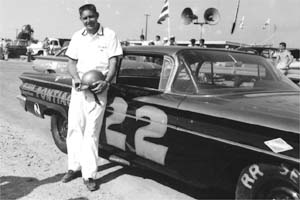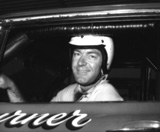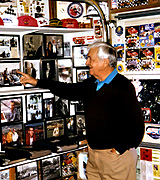The 1950 Season
Growing Pains and Growing Up
By Greg Fielden
 |
| Fireball Roberts finished second in 1950 point standings. |
Things were happening fast for Bill France as the calendar was flipped to 1950.
The Strictly Stock division was undergoing a name change -- and the new Grand Nationals took over the headlining role as NASCAR's premier series. The name Grand National was derived from England's thoroughbred horse racing event. "Grand National indicates superior qualities," said a NASCAR statement. France felt the 'Strictly Stock' label was more of a guideline for rules; 'Grand National' was a dynamic title that would have more appeal to the general public.
Before the early 1950 Grand National schedule had been established, two races had already been run. Because they were staged between the end of the 1949 season and the beginning of the 1950 slate, they carried no championship points.
Sam Nunis, a promoter whose executive offices were located in Reading, PA, operated Atlanta's Lakewood Speedway. He directed Indianapolis-type championship races, Big Cars, Sprint Cars and Stock Cars. Nunis announced that Lakewood Speedway -- once tagged the "Indianapolis of the South" -- would host a 150-mile Strictly Stock race on October 23, 1949. The event was open to any driver who was 21 years of age and held a valid driver's license.
The 1949 NASCAR season had ended on October 16th at North Wilkesboro. Red Byron had been crowned champion of NASCAR's new-fangled late model circuit, and he stood to collect a $1,000 prize at NASCAR's victory dinner during Daytona's Speed Week in 1950.
Nunis' shotgun scheduling of the Lakewood event caught France off-guard, but he generously offered to assist Nunis in the direction of his 150-miler. He also indicated the door would then be opened for all NASCAR members to participate.
Attendance on that pleasant autumn afternoon was 33,452, an astonishing figure which was about 59 percent more than the highest number on hand during the 1949 point season. Tim Flock, youngest member of the Flyin' Flock gang, drove his Oldsmobile past Curtis Turner in the 127th lap and led the final 24 laps to win the 150-miler. He pocketed $1,650 for his efforts.
The event was marred by serious injuries to 11 year-old Buster Henley. Buster suffered fractures to both legs when a wheel came off Bob Flock's Oldsmobile and bounded into an area heavily populated by spectators. The contest was so successful at the turnstyles that Nunis scheduled another race for November 13th. Once again, France stepped in and assisted Nunis in the direction of the show.
Rain interrupted the Strictly Stock return to Lakewood, yet a crowd of 22,000 showed up. Fonty Flock led the first 22 laps from his pole position. On lap 23, Flock was gobbled up in a five car crash in the second turn. Sara Christian, America's leading female race driver, collided with B.C. Speig and flipped her Oldsmobile on its roof. She suffered a "bruised chest" in the mishap, but her injuries were not serious. Speig broke his left hand in the crash. Other drivers involved were veteran Carson Dyer, who suffered head and hand lacerations, and Olin Allen, minor cuts and bruises. Allen Terrell was involved but escaped injury.
Curtis Turner picked up the lead, but a cloudburst halted the event after 39 laps. The remaining distance was scheduled for the following Sunday, November 20. Turner led the restart, but his Oldsmobile departed with engine problems about 80 miles into the event. June Cleveland of Augusta, GA, who had never won a stock car race of any kind, picked up the lead in the 85th lap and was in front on lap 110 when officials red-flagged the event due to darkness. Cleveland, driving D.G. Hall's Buick, was declared the winner and picked up a $1,500 check.
Racing was as wild and wooly as the untamed frontier, and every race was a showdown at high noon.
Neither Lakewood event carried points to the championship, and neither one has ever been logged in the 1949 or 1950 season wrap-ups and rundowns NASCAR often printed. They were listed in the 1950 NASCAR yearbook, but were not included in the race review for the 1949 season.
Curiously, Tim Flock and June Cleveland received credit for a win in NASCAR records, yet the cars they drove, Oldsmobile and Buick, did not get credit for a victory. The driver victories are reflected in today's NASCAR records, but the car wins are not. Apparently, they have to be considered as special events which carried no championship points.
 |
| Curtis Turner started the first Southern 500 on the pole. |
Another note of interest came before the 1950 season officially began. On December 5, 1949, the Central States Racing Association, a rival sanctioning body that dealt with midwestern short track races, announced it was going to sanction a proposed 500-mile stock car race at the new Darlington Raceway.
Peanut farmer Harold Brasington had attended the 1948 Indianapolis 500 and was thrilled at the spectacle. He figured a race of similar magnitude for stock cars would be ideal in the South. The only problem was that there was no facility capable of staging a 500-miler.
Brasington decided he would build such a race track. Completion was scheduled for the summer of 1950. NASCAR President Bill France was a little leery of a 500-mile race for stock cars. He feared that if the Strictly Stock automobiles broke down before the 500 miles were completed, it would be a black eye on the sport. Compared to other forms of racing, stock car racing could become a laughing stock.
The "official" 1950 season got underway at Daytona on February 5, 1950. Harold Kite, driving in his first Grand National race, won in a Lincoln. It was the first of 19 Grand National races for the season and kicked off what might be the most electrifying battle for the championship in the history of NASCAR.
Technically - due to the first scheduling of 'same day' Grand National races in different parts of the country - the lead changed hands in the point race no less than 10 times in the 19 races. Seven different drivers were atop the point standings during the 1950 season.
Defending champ Red Byron had the point lead after Charlotte's April 3rd race, having finished second and fourth in the first two starts. The crafty red-head appeared poised to make another run for the championship. But before mid-season, Byron was stripped of all his points for competing in a non-NASCAR sanctioned event. Penalties were stiff in the infant years for driving in so-called 'outlaw' events, and Byron was the first notable driver in 1950 to be handed a reprimand.
Lee Petty was another driver bitten by NASCAR's iron hand. During a three-week lull in the Grand National tour in July, Petty wandered outside the NASCAR sanctioned boundaries and paid dearly for it. Through eight races the Randleman, NC Plymouth driver had accumulated 809 points, which was good enough for third place in the standings. He was only 24.5 points out of first place in the wide open scramble for the lead. After NASCAR took all his points away, he had to start at zero in late July.
Another interesting announcement came in July. Sam Nunis declared that the first 500-mile stock car race would take place at Lakewood Speedway before Labor Day. Nunis' promotion would be open to both American and foreign automobiles. They would battle for 500 laps on Lakewood's dangerous and dusty oval.
 |
| Tim Flock won $1650 for "strickly stock" victory at Lakewood Speedway. |
So, by mid-summer, both the CSRA and Sam Nunis were talking about staging America's first 500-mile race for stock cars. Interest and media hype were soaring. Although France was skeptical of a 500-miler, he was forced to play his hand. He met with Brasington at the nearly completed Darlington International Raceway and was informed that CSRA was having difficulty getting drivers to send in their entries. France then called Mason Benner, president of CSRA, and informed him that his Southern based drivers would most certainly fill the 75-car starting field. France and Benner worked out a deal whereby Darlington Raceway's Southern 500 would be co- sanctioned by CSRA and NASCAR.
France felt it was necessary to take a step in some direction - the prospect of a 500-miler at Lakewood was scary. Once France and Benner signed the dotted line, Nunis decided to abandon ideas of holding a Lakewood 500. It was another victory for NASCAR.
The Southern 500 was the race of the year. It drew immediate national attention to a place called Darlington. The purse of $25,500 was the highest ever paid for a stock car event. Since points paralleled dollars, the winner would be assured a high finish in the point standings at year end. A bunch of dollars and a bunch of prestige were riding on the race. On Labor Day, 75 cars went to the post, and some 25,000 spectators were on hand.
Curtis Turner, who had led the point standings for five consecutive weeks, entered the Southern 500 as the point leader. He qualified for the pole with a speed of 82.034 mph. Seventy-five cars had earned starting positions in 15 days of time trials.
Turner crashed in the 275th lap, leaving him with a 60th place finish and a broken nose but no points. Johnny Mantz of Long Beach, CA, won the race by nine laps over Fireball Roberts. Mantz leaped to fifth place in the point standings.
Bill Rexford, who finished fourth, took the point lead by a 104-point margin over Roberts. Turner dropped to third. Red Byron, who wound up third in the 500, was back up to fourth place.
Later in the season, Byron once again ran an independently sanctioned affair and once again NASCAR took all his points away. He finished the year with zero points, twice having been penalized by NASCAR. Roberts, who missed seven of the first 10 races in the 1950 season, took the point lead at Langhorne, the race following Darlington. He retained his lead the following week at North Wilkesboro despite falling out with engine problems.
Then, with three races to go, Rexford took the lead with a sixth place finish at Vernon, NY. Roberts had not entered. After the 17th of 19 races, Roberts was back on top by a slim margin, having finished sixth at Martinsville. But later that same afternoon in a Grand National at Winchester, IN, Rexford finished third and retook the point lead.
In the final event of the year at Hillsboro, NC, both drivers had a shot at the title. Rexford departed early, leaving the door open to Roberts. Needing only a fifth place finish to sew up the 1950 championship, Roberts opted against driving conservatively - he charged to the checkered. Then on lap 126 of the scheduled 200 lapper, the engine in Roberts' Oldsmobile blew up, dropping him to 21st in the final rundown. He would earn no points, and Rexford was declared the 1950 Grand National champion.
Lee Petty wound up third in the final standings, having won at Hillsboro. His point total for the year was 1,590. Had he not been stripped of the 809 points in July, his total would have been 2,399, some 440 more than champion Rexford.
Byron earned a total of 1,630 points in only four 1950 starts, which would have been good for fourth place in the final tally. But the free-spirited veteran raced wherever and whenever he wanted to. No exclusive sanction for him. His name did not appear at all in the 1950 NASCAR Grand National point standings.
Overall, it was a very good year for Bill France and NASCAR. Racing was as wild and wooly as the untamed frontier, and every race was a showdown at high noon. In the 19 Grand Nationals, an incredible 14 different drivers reached the cherished confines of victory lane.
The 1950 Grand National season was real firewagon racing -- filled with magic moments and magical men.

